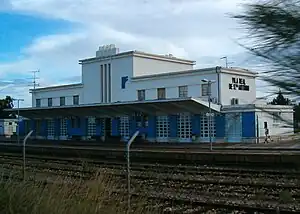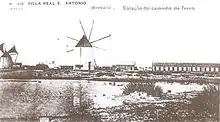Vila Real de Santo António station Estação Ferroviária de Vila Real de Santo António | ||||||||||||
|---|---|---|---|---|---|---|---|---|---|---|---|---|
 Vila Real de Santo Antonio station, 2008 | ||||||||||||
| General information | ||||||||||||
| Location | Vila Real de Santo António Portugal | |||||||||||
| Coordinates | 37°11′59″N 7°25′18″W / 37.19969°N 7.42157°W | |||||||||||
| Elevation | 5m | |||||||||||
| Line(s) | Algarve line (1906-present) | |||||||||||
| Tracks | 3 | |||||||||||
| History | ||||||||||||
| Opened | 14 April 1906 | |||||||||||
| Services | ||||||||||||
| ||||||||||||
The Vila Real de Santo António railway station is a station on the Algarve line that serves the city of Vila Real de Santo António, in the district of Faro, Portugal. The original station went into service on 14 April 1906,[1] and the new building was inaugurated on 4 September 1945.[2]
History
Planning and Construction
On 13 May 1904, a decree was published ordering studies to be carried out for the installation of the Vila Real de Santo António station, on the site that had been preferred by the population.[3] It was then expected that the locomotives would arrive in Vila Real de Santo António within a year or so.[4]
On 11 January 1905, a tender was held for earthworks in the stretch from Cacela to Vila Real de Santo António.[5]
One of the reasons for opening the line to Vila Real de Santo António was the need to better serve the agricultural fields in the eastern Algarve by rail.
Inauguration

The section between Tavira and Vila Real de Santo António entered service on 14 April 1906 and was then considered part of the South Line.[6][7] However, the inauguration was criticised in an article published in Tavira's O Heraldo newspaper, which accused the government of having opened the line to traffic before it was completely finished, in order to benefit political circles in the eastern Algarve. According to the article, the Vila Real de Santo António railway station entered service without meeting the necessary conditions for its functions, and the houses for the staff, the remise and the turntable, among other infrastructures, had yet to be built.[8]
1930s/1940s

Vila Real de Santo António's first station was located in an area that was then far from the city and the river, so that an international bridge could be built in the future to connect it to the Spanish railway network.[9] However, this created access difficulties, making it necessary to cross an area of sand and marshland to reach the station.[10]
The installation of a new interface was therefore planned, and in 1940 a brigade of engineers visited Vila Real de Santo António to choose the site for the new station.[11] Meanwhile, the design for the new station building had already been drawn up by the architect Cottinelli Telmo in 1936.[12] On 4 September 1945, the new interface was inaugurated.[2][13]
1950s/1960s
In the early 1950s, the station housed a delegation from the National Information Secretariat.[9]
On 1 November 1954, the automotive services between Lagos and Vila Real de Santo António began.[14] In 1956, the Compagnie Internationale des Wagons-Lits ran three services on the trains between Barreiro and Vila Real de Santo António: one with sleeping cars, one with dining cars and one with canteens.[15]
On 20 June 1969, the Board of Directors of Companhia dos Caminhos de Ferro Portugueses approved the creation of excursion trains between Vila Real de Santo António and Lisbon, as a way of combating the growing competition from road transport in the southern region.[16]
1990s
In 1991, the Inter-regional trains between Vila Real de Santo António and Lagos began circulation.[17]
21st century

By January 2011, this station had three tracks, two 437 meters long and the third 407 meters long; only the first two lines had platforms, both 133 meters long, the first 35 centimeters high and the second 40 centimeters high[18] — values later changed to the current ones.[19]
See also
References
- ↑ TORRES, Carlos Manitto (1 February 1958). "A evolução das linhas portuguesas e o seu significado ferroviário" (PDF). Gazeta dos Caminhos de Ferro. Vol. 70, no. 1683. pp. 76–78. Retrieved 7 February 2014.
- 1 2 CAVACO, 2001:60
- ↑ NONO, Carlos (1 May 1950). "Efemérides ferroviárias" (PDF). Gazeta dos Caminhos de Ferro. Vol. Ano 63, no. 1497. pp. 113–114. Retrieved 10 September 2015 – via Hemeroteca Digital de Lisboa.
- ↑ "Há 50 anos" (PDF). Gazeta dos Caminhos de Ferro. Vol. Ano 67, no. 1594. 16 May 1954. pp. 130–131. Retrieved 22 December 2015 – via Hemeroteca Digital de Lisboa.
- ↑ NONO, Carlos (1 January 1949). "Efemérides ferroviárias" (PDF). Gazeta dos Caminhos de Ferro. Vol. Ano 60, no. 1465. pp. 25–26. Retrieved 10 September 2015 – via Hemeroteca Digital de Lisboa.
- ↑ MARTINS et al, 1996:252
- ↑
- ↑ "Inauguração da estação de Villa Real" (PDF). O Heraldo. Vol. Ano 24, no. 1239. Tavira. 14 April 1906. p. 2. Retrieved 26 September 2022 – via Hemeroteca Digital do Algarve.
- 1 2 MAIO, Guerra (1 November 1951). "Lisboa - Algarve - Sevilha" (PDF). Gazeta dos Caminhos de Ferro. Vol. Ano 64, no. 1533. pp. 341–342. Retrieved 18 September 2015 – via Hemeroteca Digital de Lisboa.
- ↑ CAVACO, 2001:59
- ↑ "Linhas Portuguesas" (PDF). Gazeta dos Caminhos de Ferro. Vol. Ano 52, no. 1254. 16 March 1940. p. 186. Retrieved 10 September 2015 – via Hemeroteca Digital de Lisboa.
- ↑ MARTINS et al, 1996:133
- ↑ "Parte Oficial" (PDF). Gazeta dos Caminhos de Ferro. Vol. Ano 61, no. 1470. 16 March 1949. pp. 224–227. Retrieved 10 September 2015 – via Hemeroteca Digital de Lisboa.
- ↑ "Linhas Portuguesas" (PDF). Gazeta dos Caminhos de Ferro. Vol. Ano 67, no. 1606. 16 November 1954. p. 334. Retrieved 22 December 2015 – via Hemeroteca Digital de Lisboa.
- ↑ ALVA, Conde de Penalva de (16 October 1956). "A C.P. e os Wagons-Lits" (PDF). Gazeta dos Caminhos de Ferro. Vol. Ano 69, no. 1652. pp. 465–466. Retrieved 5 March 2017 – via Hemeroteca Digital de Lisboa.
- ↑ MARTINS et al, 1996:272
- ↑ REIS et al, 2006:150
- ↑ "Linhas de Circulação e Plataformas de Embarque". Directório da Rede 2012. Rede Ferroviária Nacional. 6 January 2011. p. 71-85.
- ↑
Bibliography
- CAVACO, Carminda (1976). O Algarve Oriental: As Vilas, O Campo e o Mar. Vol. 1 de 2. Faro: Gabinete de Planeamento da Região do Algarve. p. 204.
- CAVACO, Carminda (1976). O Algarve Oriental: As Vilas, O Campo e o Mar. Vol. 2 de 2. Faro: Gabinete de Planeamento da Região do Algarve. p. 204.
- CAVACO, Hugo (2001). Toponímia de Vila Real de Santo António. Vila Real de Santo António: Câmara Municipal. p. 102.
- MARTINS, João; BRION, Madalena; SOUSA, Miguel; et al. (1996). O Caminho de Ferro Revisitado: O Caminho de Ferro em Portugal de 1856 a 1996. Lisboa: Caminhos de Ferro Portugueses. p. 446.
- REIS, Francisco; GOMES, Rosa; GOMES, Gilberto; et al. (2006). Os Caminhos de Ferro Portugueses 1856-2006. Lisboa: CP-Comboios de Portugal e Público-Comunicação Social S. A. p. 238. ISBN 989-619-078-X.
- URBANO, Ludgero (June 1995). História da Mecanização e Agricultura: Algarve. Faro: Direcção Regional de Agricultura do Algarve. p. 307.
- Ricardo Alexandre Ferreira Guerreiro: A arquitetura das estações de caminho-de-ferro em Portugal no início do século XX : quatro estudos de caso (dissertação para a obtenção do grau de Mestre). Universidade Lusíada / Faculdade de Arquitetura e Artes: Lisboa, 2017.01.09: pp.124-152
External links
- Página sobre a Estação de Vila Real de Santo António, no sítio electrónico da operadora Comboios de Portugal
- Página sobre a Estação de Vila Real de Santo António, no sítio electrónico Wikimapia
- Página com fotografias das Estações de Vila Real, Vila Real de Santo António e de V. R. de St.º António-Guadiana, no sítio electrónico Railfaneurope
- Página sobre a estação de Vila Real de Santo António, no sítio electrónico Mapio
- Estação Ferroviária de Vila Real de Santo António na base de dados SIPA da Direção-Geral do Património Cultural